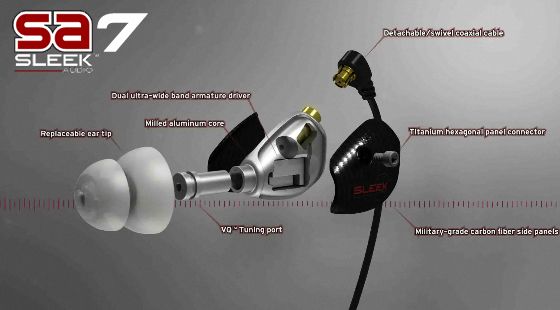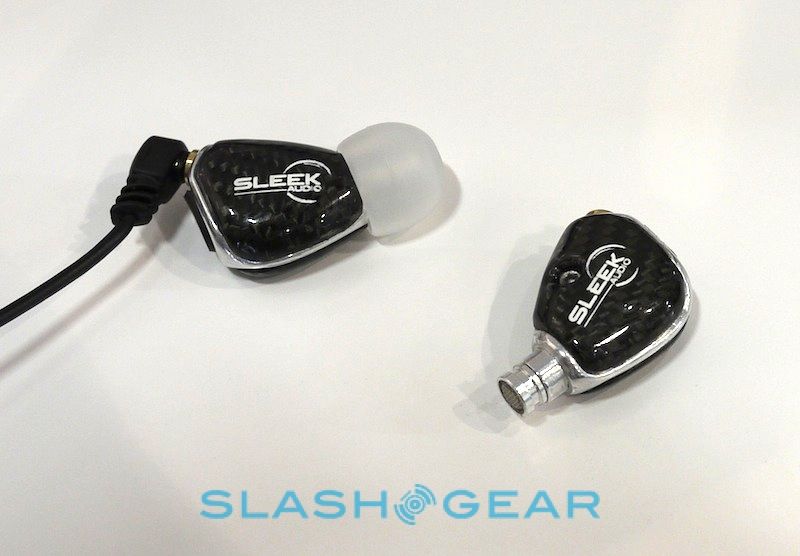Sleek Audio SA7 and SA6R (update: SlashGear Prototype Preview)
- Thread starter ClieOS
- Start date
mvw2
Headphoneus Supremus
Yuuuuuuuuuuummmmmmmmmmmmmmmyyyyyyyyyy!!!!!!
Yeah, agreed! I look forward to the forthcoming impressions on the SA7. Could be promising.
mvw2
Headphoneus Supremus
Quote:
The SA6 were not too good in terms of build quality and sound. The SA7 looks like at least fixes the former but the latter is also needed if Sleek wants a future.
You may underestimate what the SA6 offered. The driver used is an interesting one. It does two things that are hard for a lot of BA earphones.
1) It offers an unusually natural presentation, as in speed, dynamics, note thickness, etc. It doesn't specifically sound BA like. The only other earphone that I've used that is like it is the CK90Pro. The SA6 response really well to EQing too, so the low end can be bumped up and end up being quite natural and extended. The treble is not fixable. It is smooth and laid back. Intensity wise, the treble isn't even rolled off. It's actually a little hot, but he presentation is very laid back making it sound rolled off despite the sensitivity being there.
2) It offers a sense of openness and air. SO few earphones do this. While the sound stage isn't great in terms of placing a sound in a pinpoint location in mental space, it is open and completely transparent. I have not used another earphone that's been as good in this sense, not one.
I do agree there can be improvements and the big issue was the single driver and inherent limitations with frequency response range. A dual driver seems quite needed to effortlessly cover the hearable spectrum. The SA7 should fix this. Oddly, I kind of expect the SA7 to approach something more like the SE530 in setup. The SA6 is mid centric to start with, like the SE530, and Sleek Audio seems to want that gearing. I will be curious how they tune the dual driver setup.
I never though the build quality was bad. I thought it was quite good actually, at least for such a compact device. For what they were trying to do, they did well. I feel it's less fragile than people think. The new design is even better. It seems a big goal was to develop a product that is very tough and picked some smart design choices.
I am also curious what Sleek Audio has up their sleeves designing the drivers like they are. This opens up the possibility to swap in different drivers into the earphone. Want the ER4 driver in a SA6R/SA7 package with port tuning? You might be able to.
- Joined
- Jul 7, 2007
- Posts
- 1,283
- Likes
- 46
Those are beautiful...
xtasi
100+ Head-Fier
- Joined
- May 15, 2010
- Posts
- 326
- Likes
- 17
sa7 has no bass tuning port?
LoganT
Head-Fier
- Joined
- Jul 21, 2009
- Posts
- 67
- Likes
- 1
I think I might upgrade from the Triple.FI 10's.
It's this, IE8 or X10i.
It's this, IE8 or X10i.
gerbi
100+ Head-Fier
I did enjoy the Sa6 with the only criticism being the plastic treble ports. I'm really looking forward to laying my hands on a pair of these!
xtasi
100+ Head-Fier
- Joined
- May 15, 2010
- Posts
- 326
- Likes
- 17
Quote:
Check out the first post.
Yeah I know it says it does, but from the picture dissecting the SA7, they didn't label any bass-tuning port.
BTW, do you think the SA6R will replace the SA6? If so I hope prices drop so I can grab one
Quote:
They probably just forgot to put it in the animation. As you can see in the SlashGear preview, the bass port is still there.
Quote:
Very likely yes. But my guess is the initial price is not going to be lower than the current SA6's MSRP of $250.
Yeah I know it says it does, but from the picture dissecting the SA7, they didn't label any bass-tuning port.
They probably just forgot to put it in the animation. As you can see in the SlashGear preview, the bass port is still there.
Quote:
BTW, do you think the SA6R will replace the SA6? If so I hope prices drop so I can grab one
Very likely yes. But my guess is the initial price is not going to be lower than the current SA6's MSRP of $250.
Kunlun
Headphoneus Supremus
- Joined
- Jan 25, 2010
- Posts
- 3,750
- Likes
- 386
From the review, it looks like these are going to be great--and they will have a rawster-esque sound signature.
deaththeorist
Head-Fier
- Joined
- Apr 18, 2010
- Posts
- 64
- Likes
- 10
i wonder if it'll be the same tiny size as the sa6s... disappear in your ear! lol
Kunlun
Headphoneus Supremus
- Joined
- Jan 25, 2010
- Posts
- 3,750
- Likes
- 386
Quote:
Quote:
Originally Posted by KLS /img/forum/go_quote.gif
I was thinking the same too. TF10 also have similar size I think. By the way from my little experience grill wax-guard is usually used in dynamic IEMs.
I think it has to do with the size of the nozzle. With my shures the nozzle was so tiny that I never had to clean it (nothing got in).
From my experiences it seems the reason for a larger nozzle with dynamics vs. BA is that the BA drivers are fully self contained and use acoustic "piping" to move the sound around, whereas dynamics take up the full space in the IEM and require a large nozzle for bass presence. So then, is this another one of those unholy hybrids? (I hope so).
EDIT: I guess if it had enough drivers like the triple.fi then it might merit a bigger nozzle.
(I'm not really sure what I'm talking about here but it can't hurt to speculate).
You're exactly wrong. Our resident audio engineer Kwkarth explained it a while back. The nozzle size is one more feature of an iem that helps tune the sound--smaller nozzles help to bring out the bass (something that engineers working with a BA iem often want to do, but not always), while larger nozzles allow for more treble presence (something that a designer of a dynamic iem might want to do, but not always). Again, it's just one factor. Someone can link to the explanation or you can search for it.
Users who are viewing this thread
Total: 1 (members: 0, guests: 1)







